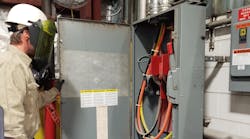October 2017 saw the release of the 2018 edition of NFPA 70E, Standard for Electrical Safety in the Workplace. As part of my continuing education — and to recertify for NFPA’s Certified Electrical Safety Compliance Professional (CESCP) credential — I attended an NFPA-provided, two-day training course on this standard. As the session unfolded, our class was introduced to a new requirement in the 70E standard that addressed the “host employer’s electrical safety plan.” As outlined in Sec. 105.3 of the standard:
“(A) Employer Responsibility. The employer shall have the following responsibilities:
(1) Establish, document and implement the safety-related work practices, procedures required by this standard.
(2) Provide employees with training in the employer’s safety-related work practices and procedures.”
I soon found myself thinking about the magnitude of this challenge. The inclusion of this requirement places a major emphasis on an employer to have a written/documented electrical safety program. The process of documenting the electrical safety plan requires a comprehensive assessment of what is in place today with a logical next step to evaluate, by the NFPA 70E standard, what should be in place at a future date.
As I began discussing this new addition to the 70E standard with my customers, it became apparent that many of them were looking for more guidance on how to go about achieving compliance. They wanted to know what portions of the standard pertained to their facility and work practices. Note: NFPA 70E offers Informative Annex E — Electrical Safety Program as a starting outline.
In February 2018, our company offered a one-day workshop that presented the details of Annex E, hosting more than 40 attendees. Several months later, the consensus of the group was the training/workshop content successfully presented the Annex E outline but was not effective in helping these organizations with the development of their written electrical safety programs. Many of my client contacts were still very concerned about meeting the requirements of this standard but were uncertain about how to proceed. One additional realization was a key ingredient to finding a workable approach.
Every Annex within the NFPA 70E standard begins with this statement:
“This informative annex is not part of the requirements of this NFPA document but is included for informational purposes only.”
In other words, you can design your own program as long as you meet core 70E requirements. At this point, we decided to develop our own outline for an electrical safety program. First, we had to agree on the key requirements that should be included in the program. We settled on the following three items:
1) The electrical safety program must meet certain requirements included in NFPA 70E (Art. 110).
2) The electrical safety program needs to be grouped around key functional areas that can be developed into the overall electrical safety written program.
3) The electrical safety program must begin with an outline that is inclusive of all 70E Article/Section references.
Requirement No. 1
To be certain that the safety program included all required elements, the information in Table 1 was compiled. The electrical safety program must address all topics as outlined in Article 110. Table 1 is a listing of the electrical safety program’s required topics. One surprising result is that the text of “the electrical safety program shall include” appears only in Article 110 and not elsewhere in the 70E document.
Requirement No. 2
The second requirement demanded that the 70E requirements be developed around functional areas. The first area defined in our process was “electrical system management” and the “condition of maintenance” requirements of the arc flash study. The core of our project methods focused on the inventory and condition of maintenance requirement for inspection and testing of electrical components.
As I reviewed competitive offerings by other arc flash provider/vendors, many times the solution set had no metrics of condition of maintenance. Therefore, the project scope (and price point) did not address the 70E requirements in this area. As we focused on “safety-related maintenance” standards within 70E, “electrical system management” was identified as the first functional topic. Once we identified this first category, the remaining categories were developed based upon an overall review of the various articles and sections in the standard.
Our electrical safety plan now consists of the following sections:
• Electrical system management
• Electrical safety training
• Risk management
• Task management
• Auditing
A key milestone of this effort was the outline for the functional electrical safety plan as shown in Table 2.
Requirement No. 3
The third requirement is to ensure that all 70E requirements are included in the electrical safety plan. The basic concept seemed simple: Take each 70E requirement (by creating an inventoried listing as shown in Table 3), and then assign that item to a functional section of the plan. For example, Sec. 110.1(C)(condition of maintenance) was assigned to “Electrical System Management.”
We first created the full inventory of 70E topics, and then completed a process of assigning that topic to a safety plan section. Table 3 shows a sample listing of 70E topics. This classification process did run into a challenge in that many of the 70E topics could be classified into more than one section of the functional safety plan outline. With the acceptance of the concept that a 70E topic could be referenced in one or more of the five functional areas, a complete outline for the content of each functional area resulted. Each functional area of the plan now had a full listing of the 70E references/topics.
The Last Challenge
The last challenge was that 70E requires a specific structure of the electrical safety plan. The standard states that an electrical safety plan must have a structure of principles, controls, and procedures. The buildout of the Table 3 listing of 70E standard into the five functional areas did not consider this additional required structure. It simply provided a table of content for that functional area.
As we continued to work on the development of the written plan, our last challenge was to ask the question: Within 70E, what is a “principle”? What is a “control”? What is a “procedure”? The development of these working definitions was the last roadblock in developing the written plan.
The standard’s Article 100 [Definitions] does not have entries to explain or define principles, controls, and procedures. It does, however, have a new definition for “electrical safety program,” which is a documented system consisting of electrical principles, policies, procedures, and processes that directs the activities appropriate of the risk associated with the hazards.
As we continued to develop the electrical safety program, the following “working definitions” came into focus.
Principles — A value statement about the topic. For example, our facility will have a program where all electrical components will be tested and inspected every two years.
Procedures — A description of the “what and how.” Once a principle “value statement” was written, it was easier to focus on the procedures/requirements to further develop the topic. What are the metrics of testing and inspections, including IR testing, ultrasonic testing, visual inspection, and perhaps other tests and inspections? The “what and how” became the definition of procedures.
Controls — How will we document and measure? The final required element is controls. The means to document the procedures and tasking of procedure became the definition of controls.
Conclusion
After all of this had been accomplished, there remained the process of understanding many existing practices and programs that are currently in place at a client’s site and committing them to a written electrical safety plan. This calls for in-house programs to be audited for their contributions to the broad requirements of the site’s electrical safety plan.
Hopefully, a renewed approach using this new plan with its focus on the functional areas of the 70E standard can successfully help guide your efforts to establish, document, and implement the safety-related work practices and procedures required by this standard.
Fox is the owner of ASG Electric in Madison, Wis. He has held the NFPA Certified Electrical Safety Compliance Professional (CESCP) certification since 2014. He can be reached at [email protected].







